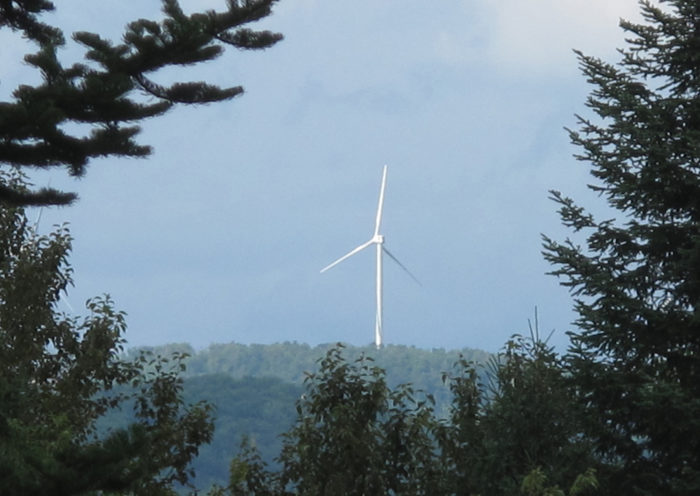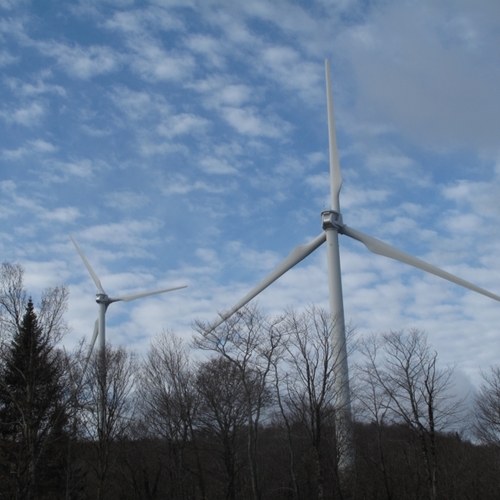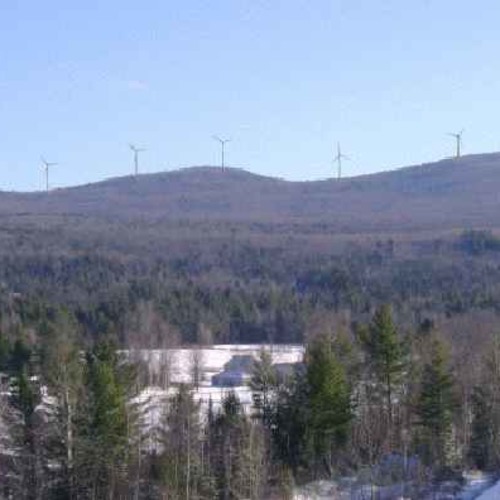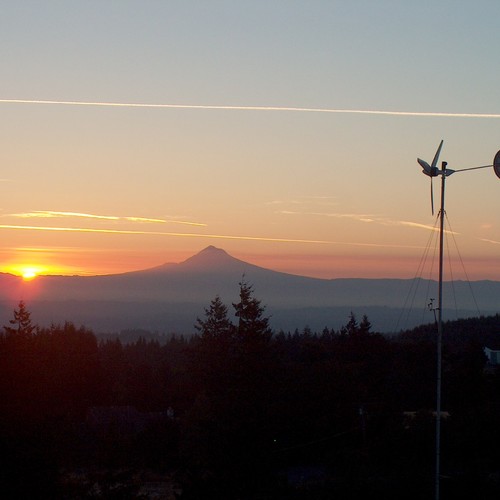
Image Credit: Martin Holladay
I live in Wheelock, Vermont, a town with 598 residents. Our town is so small that we have neither a post office nor a zip code. To get my mail, I have to travel two miles to the post office in Sheffield, our larger neighbor. (Sheffield has a population of 704.)
There’s a $90 million construction project underway in Sheffield this summer. In its entire 200-year history, the sleepy town has never seen anything like this.
A company called First Wind is installing 16 utility-scale wind turbines, each 420 feet tall, on a Sheffield ridgeline. When I drive down the gravel road from my house to the post office, there’s a spot on the road where I can glimpse the new turbines on the horizon. When they go online next winter, the turbines will generate 115,000 megawatt-hours per year — enough electricity to meet the needs of every home in Caledonia County.
Deep snow, plenty of moose, and four tranquil ponds
The wind farm is located on Duck Pond Road. To those of us who live nearby, Duck Pond Road, a gravel road that passes over Sheffield Heights, is the back way to Barton. Most of the road passes through undisturbed woods, and until this summer, the road got almost no traffic. There are a handful of hunting camps on Duck Pond Road; none of them have electricity.
Over the past few decades, I’ve enjoyed snowshoeing on the west side of Duck Pond Road, where it’s fun to travel between the area’s four high-altitude ponds. The last time my friend Bill and I went snowshoeing up there, we didn’t see anybody all day. But we did see plenty of moose tracks.
The development now under way in Sheffield is the first commercial wind development in Vermont in 10 years, and the…
Weekly Newsletter
Get building science and energy efficiency advice, plus special offers, in your inbox.

This article is only available to GBA Prime Members
Sign up for a free trial and get instant access to this article as well as GBA’s complete library of premium articles and construction details.
Start Free TrialAlready a member? Log in















20 Comments
right on
too bad it takes
right on
too bad it takes society so long to change its ways, how long did it take seat belt use to get widely adopted? 10, 20 yrs?
thank you
thank you Martin for another thoughtful posting
Spot on!
Hi Martin,
Well put!
I had a good friend email me an article that questioned Ontario's Feed in Tarriff program (FIT). She has concerns about winds' economics inspired by her municipality's ideal wind conditions .
Ontario's FIT program sets a price for renewables that gives entrepreneurs enough incentive to build both wind and solar. The entrepreneurs take the capital risk to build the new electricity supply. Compare that with the nuclear facilities the province built a couple of decades ago which had huge cost overruns (unsurprisingly). On every electricity bill in Ontario their is a debt retirement charge for those facilities. The FIT program transfers the risk to the entrepreneur not Ontario's citizens. But folks are up in arms!
People have no idea what there electricity really costs, or how much the primary fuel used to generate that electricity costs, or that the supplies of those primary fuels are declining.
And as you point out there is the real and pressing need to deal with climate change which will require an almost complete transformation of our energy infrastructure in the next few decades.
I can understand what is driving my friends concerns, but I also stop and think of the very large home that she built a few years ago. Very high ceilings, double glazed windows, and conventional framing with no thought to energy efficiency. So that light reaches the floor from the very high ceilings high powered incandescents were installed! And the water for the radiant floor is heated with natural gas, and it's looking like natural gas isn't going to get us out of the fix were in (oil drum ); or be a cheap fuel source for electricity generation.
I wish people would put some effort into understanding where the energy they use comes from and what the real costs are for them to be able to use it! A little effort and intellectual honesty is needed.
Thanks as always for your reporting and commentary.
Andrew
1998 Ice Storm Blackout and Eastern Ontario PV Generation
Hello Martin,
Great article.
In January 1998, "The Ice Storm" slammed Eastern Ontario, Southern Quebec and some of the New England States. We were without power for 12 days. Not far from us, neighbours were blacked out for almost three weeks. Closer to the US border, conditions were even worse. Fortunately, for the duration of the blackout, the temperature remained close to the freezing point. If this inconvenient event had been combined with a major deep freeze, the situation would have been critical. Many people would have died and thousands of homes would have froze up.
There were several causes of the black out. The freezing rain coated the power lines with more than an inch of ice. This weight either dragged the lines down or the wires connected and short circuited. Wooden poles snapped and steel towers twisted like pretzels. Trees collapsed and fell onto the lines - severing the connection. (My enduring Ice Storm memory is the sound of the trees dieing. There would be a loud crack, like an artillery gun firing, followed by a crash and the sound of a thousand chandeliers shattering.)
In Eastern Ontario, our power is generated at sites hundreds of miles away. These long transmission lines make the grid vulnerable to events such as freezing rain and high winds.
Ontario's new FIT and MicroFIT programme, which Andrew Henry mentioned, has several advantages. The electricity generated by wind, solar and hydro is renewable. While these sources may have some disadvantages, they are primarily green, nonpolluting in the traditional sense and environmentally friendly. A major logistical benefit of using these generating sites is that they are local to the consumer. There is less line loss. Transmission lines do not traverse hundreds of miles of forests and agricultural land. If we experience another Ice Storm or similar events, the local grid may suffer, but the damage will be limited. Repairs to the transmission grid will be less complicated and faster.
Last night, I attended a public meeting organized by a company which wants to develop five PV solar farms in Eastern Ontario. Each site will generate 10 Megawatts. There were a few people who had intense objections to the facilities. Many of their concerns are legitimate. This is a rural area where residents rely on drilled wells for water. Our county is very rocky with very little soil. Construction may require drilling which could fracture the subsurface rock. Any fracturing of the bedrock could allow surface water to contaminate the water table.
There is concern that construction traffic will damage the roads, increase the dust levels, and endanger local children. The construction and traffic noise is also a concern.
The local fire department relies on volunteers. They do not have the training and special equipment required to fight a major electrical fire. They primarily use water to fight fires. Water doesn't mix well with electricity. A fire at night would be less risky than an emergency which occurs on a sunny afternoon, when the panels are generating power at their maximum capacity.
Some residents are afraid that the presence of a PV farm will affect the resale value of their homes.
Another fear is that the presence of electromagnetic fields could result in health risks.
Unfortunately, the corporate officials did not have many answers to reassure these concerned homeowners and neighbours. As someone who supports the use of renewable energy sources, I was disappointed by the lack of preparedness of the company's representative. The company began preparing for these projects about five years ago.
As you pointed out, would the residents who object to the installation of the PV farms or, in your case, the wind generating sites be willing to substantially alter their lifestyle and reduce their electrical consumption? Are their homes designed to perform at Near Net Zero levels? - Jim
Great Post
Hi Martin,
Just wanted to say Hi and great post! Even though we haven't crossed paths since my Miller's Run days teaching I've enjoyed your articles.
We see the towers from down the road and in time I think people will accept them. I haven't heard anyone complaining about the darn telephone/electric poles and lines recently but I'm guessing when they first started there was a bit of an uproar!
Response to Todd Vendituoli
Good to hear from you, Todd -- and thanks for the feedback.
I agree with you about the visual pollution of overhead utility lines and poles. For some unexplained reason, we all put up with that pollution with very little complaint.
Nice article, when will people care?
The majority of people will only care enough to find out where their energy comes from when it stops coming. Without projects like Martin describes above, that could be very soon!
Those of us who do know need to be at those town meetings, in serious numbers!
local investment makes a difference
Not surprisingly local ownership can make a difference in community buy in to renewable energy projects. Here is a link to a recent study
http://www.renewableenergyworld.com/rea/blog/post/2011/07/local-ownership-means-local-love-for-wind-power?cmpid=WNL-Wednesday-August3-2011
trees
Hi Martin,
"There is a strong likelihood that many of the trees that now fill our northern forests will die within my children’s lifetimes"
why will the trees die?
what's your take on installing bat boxes near your house?
Response to James Brown
James,
Q. "Why will the trees die?"
A. Here is some information to get you started -- there's a lot of information on the topic on the Web:
"Climate change may dramatically after the forest composition in the Northern Forest as some species, trees and wildlife, are no longer able to survive in the new climatic conditions."
http://www.nwf.org/Wildlife/Wild-Places/Northern-Forest.aspx
"In the most heavily impacted areas, the rates at which plant and animal species may be required to shift their ranges in response to global warming in the next 100 years may be as much as ten times faster than at the end of the last ice age.
"New Hampshire has 35% of its habitat at risk, making it the 8th most vulnerable state in the nation. In New Hampshire and Maine, as well as in Vermont and upstate New York, the northern forests are the most threatened plant communities, particularly at the southern edges of their ranges.
"Unusually high migration rates are likely to affect more than 18,000 square miles of habitats (an area larger than Denmark) in Vermont, Maine, New Hampshire and New York, threatening some species with local extinction. ...
"Range changes brought about by global warming and climatic disruption are expected to change the character of the forests of northern New England and upstate New York.
"Climate models predict that in the longer term global warming will eventually transform the conifer forest of northern New England into the type of forest now found farther south – either the deciduous forest of the Mid-Atlantic States, or the mixed forests characteristic of southern New England.
"The conditions that currently support northern hardwood forests will shift up to 300 miles north during the next 100 years, causing the loss of these forests over much of the landscape. The distributions of white spruce, black spruce, red spruce, balsam fir and other species of cool climates will move north and these trees are likely to disappear from most of their current ranges in the Northeastern United States. If disturbances such as fire or storms increase as has been predicted by some scientists, this would hasten the decline.
"Current modeling forecasts predict that maple sugar trees eventually would be completely eliminated as a regionally important species in the northeastern United States. Even where sugar maples are able to persist, changes in the freeze/thaw cycle are expected to reduce the quantity of syrup harvested. Maple syrup production is worth approximately $20 million annually in New England."
http://www.cleanair-coolplanet.org/information/pdf/forest-factsheet.pdf
Q. "What's your take on installing bat boxes near your house?"
A. Such boxes can't hurt -- I've put up two -- but unfortunately white-nose syndrome has drastically reduced Vermont's bat population. I haven't seen any bats at all near my house this summer, and I always used to see them catching bugs at dusk in the past.
Nice piece
I like your point about your anti-wind neighbors leaving their incandescent lights burning on their porches all night. Down south we also contend with people leaving their paddle fans turning on their front porches 24/7 when no one is out there. Makes me crazy.
Porch fans
Carl,
Don't you realize that your neighbors are just being kind to animals? The porch fans are left on for the raccoons who lounge on the rocking chair all night.
Back Yard Wind
Great article Martin
I teach a renewable energy course in conjunction with shop classes at a Jr/Sr High school in a rural area. The wind turbine that students and I erected at the school has been wonderful for my future engineers and technicians. We have practiced problem solving on a regular basis. Only now after a few years of dealing with a small wind turbine do I feel confident enough to consider installing one on my own farm. I do, however, have students who swear by wind power and are bound to erect their own some day. I believe that proper justification is needed as well as proper introduction to ownership. A smart consumer will do more than lick their finger and hold it up to see what kind of wind they have. A quick survey of grid reliability or availability will help determine payback. In my situation the grid sends me several power bumps a year and several outages. The bumps have been responsible for taking out a well pump, cooktop, and other electronics in the house that were on at the time of the power surge, some even with surge protection in place.
My point is that wind is doable and it has its place, but you must not go at it with your eyes closed.
Old Time Wind Power
I just remembered something I read that talked about wind power being very prevalent in rural areas before the advent of central power generation. As part of the rural electrification act, individual wind turbines were required to be taken down in order to have transmission lines installed. Power company behavior hasn't changed very much, has it?
And Martin, thanks for asking about my neck, I am almost back to normal, or as close to normal as possible.
Wind generators in the 1920s and 1930s
Carl,
I recounted some of the history of rural wind turbines in the 1920s and 1930s in my November 2009 blog, Backyard Wind Turbines.
Glad to hear your neck is better.
Geothermal is a "carbon killng app" withwind power
Martin, Great comment.
It took me from 1993 to 2009 to reduce my home's CO2 emissions from ~13 to 7.6 metric tons. When I changed to wind power in 2010, emissions dropped to 1 metric ton - thanks in large measure to the fact that I have a ground source heat pump. With a heat pump, I now burn only 190 therms per year. When paired with wind power (10 grams of CO2 per kWh compared to about 900 grams for coal-fired power, and about 500 grams for natural gas), geothermal is a carbon killing app.
Thank you for your rich and most informative posts.
Bill Rau.
Sheffield turbines
I got to see the Sheffield turbines you're writing about first hand this weekend, you can see them really well from Kirby two ridges east of this installation. It's quite a sight and, in my opinion, important to finally have a built example up and running to counter the story that these few white towers would be the end of pastoral Vermont.
They look exciting and hopeful to my eye.
The larger irony is that if you pivot your view 90 degrees from the image posted below you look up at a beloved local downhill ski mountain covered in clear cuts and large metal lift towers and cables.
Response to Jesse Thompson
So, Jesse -- surely you're not suggesting that clear-cutting steep mountain slopes for the recreational pleasure of out-of-state visitors -- the backbone of our winter economy -- has negative aesthetic consequences? Get with the program, Jesse! Those are ski slopes, not clear-cuts!
Sheffield Site Photos and Video
For a better understanding of the impacts of constructing the Sheffield wind project on the mountains in Vermont, see the following site photos and video. 43% of the 60.5 acres on the project site are on slopes of 35-60%. 93% of the slopes are greater than or equal to15%. Site development required construction of about 7 miles of impervious new roads, filling headwater streams and rearranging the hydrology of the mountain.
May 3 https://picasaweb.google.com/114098560210816181304/SheffieldMay32011
May 6 https://picasaweb.google.com/114098560210816181304/SheffieldMay62011
May 8 https://picasaweb.google.com/114098560210816181304/May82011
May 18 https://picasaweb.google.com/114098560210816181304/May182011?authkey=Gv1sRgCMSIh-v7tP2W0AE
Sheffield Site Construction Photos: Short Version http://vimeo.com/26965317
Sheffield Site Construction Photos: Long Version http://vimeo.com/26936501
Sheffield Site Flyover July 23, 2011: http://vimeo.com/26833522
Great photos annette
These are a little more realistic. The project is certainly out of scale and
out of character for our state... thanks for showing the project for what it is...
The project can't be seen from Sheffield... It is painfully visible from every other
neighboring town....
Sheffield Vermont
Log in or become a member to post a comment.
Sign up Log in